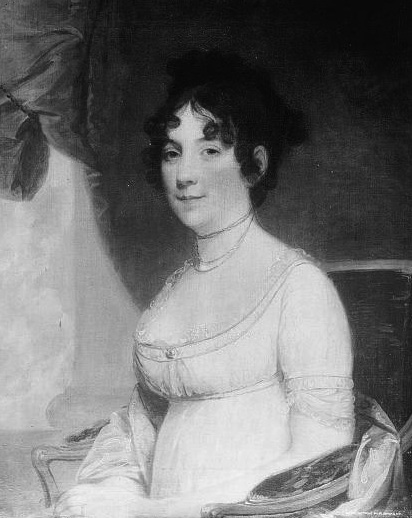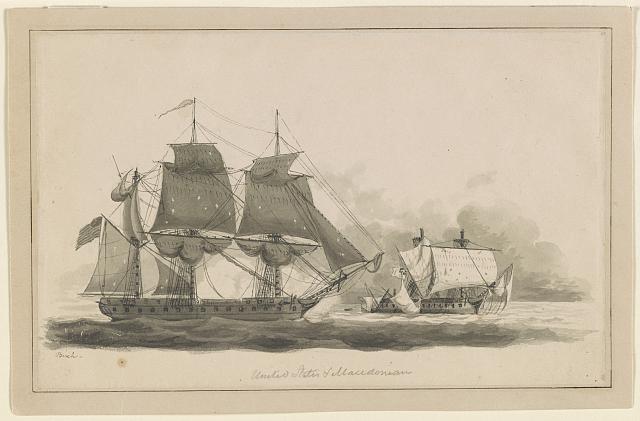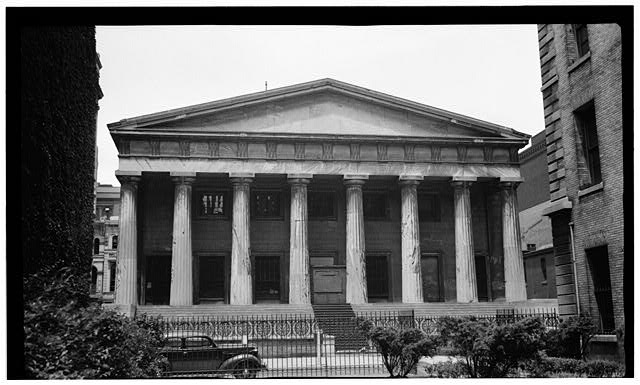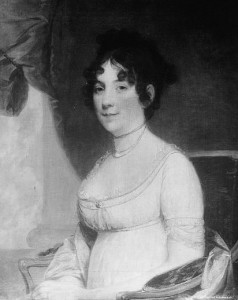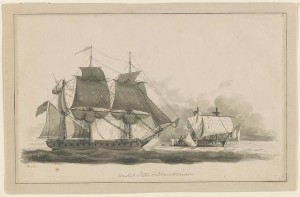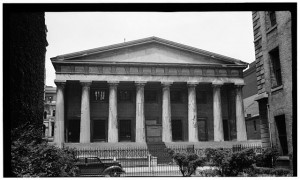War of 1812
Essay
Philadelphia was pivotal in supporting America’s war effort during the War of 1812, the final war in which the United States and Britain fought on opposing sides. The city functioned as a major supply center for the army, and its revitalized port outfitted vessels for the navy. People from the Philadelphia area operated war-related businesses, helped build fortifications, and traveled far from home to fight on land and sea. In the aftermath of the conflict, as the country was embroiled in a severe economic downturn, Philadelphia evolved as a focal point for attempting a national economic resurgence as it became the base of operations for the Second Bank of the United States.
The War of 1812’s beginning had roots in Philadelphia. It was here, on June 3, 1811, that William Henry Harrison (1773-1841) began his regiment’s march to the Indiana Territory. Several months later, on November 7, 1811, the unit fought the Shawnee at Tippecanoe. Some historians consider this the first battle of the War of 1812, as it made the First Nations tribes realize that an alliance with Britain was their best hope of maintaining self-determination.
Pennsylvania’s support for the war was substantial. The state provided the largest vote in Congress for the war’s declaration and later played a key role in reelecting James Madison (1751-1836) in the 1812 presidential race against Dewitt Clinton (1769-1828). The election was a referendum on the war, and a loss for Madison likely would have led to efforts to find an expedient conclusion.
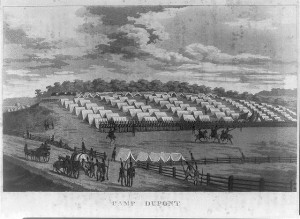
Debate Over Raising Troops
In contrast with Pennsylvania, most congressmen from neighboring Delaware and New Jersey had voted against declaring war. Delaware Federalist James A. Bayard (1767-1815) was the minority leader in the Senate, and Federalist opposition was unanimous. (Bayard later became one of five Americans to sign the 1814 Treaty of Ghent, which established peace terms between the United States and Britain.) All of New Jersey’s delegates were Democratic-Republicans like President Madison, yet they, along with other anti-war congressmen, believed the nation was militarily unprepared and that overseas commerce would suffer. Nevertheless, both Delaware and New Jersey acquiesced in raising troops.
Philadelphia-area residents from all economic and social backgrounds participated in the war effort. Many who joined militias fought in campaigns in the western territories, Niagara Theater, and Chesapeake region. A large number of the recruits were Irish immigrants who had recently arrived in East Coast cities like Philadelphia and were eager both to oppose the British and find opportunities to lift themselves out of poverty. On the home front, the yard of the Pennsylvania State House (Independence Hall) became an active place for drilling troops and gathering civilians for war-related labor. In 1814, when a British invasion of Philadelphia became a distinct possibility, African American businessmen James Forten (1766-1842) and Russell Parrott (1791-1824) used the yard for organizing more than two thousand free Black people to help strengthen fortifications at Gray’s Ferry on the Schuylkill River.
The war saw Philadelphia reclaim its position as an essential port for the United States Navy. Shipyards on the Delaware River busily engaged in shipbuilding and repair. However, not all the region’s maritime industries thrived. The British Navy’s frequent presence on the Delaware Bay adversely affected fishermen and traders. While the British never sailed as far upriver as Philadelphia, the town of Lewes, Delaware, was not so fortunate. On April 5 and 6, 1813, after refusing to provision a British flotilla, Lewes was bombarded for twenty-two hours. Delaware militia defending the town managed to keep British troops from landing on shore, and the attackers eventually withdrew.
As the United States continued waging a war that it did not have the adequate finances to afford, it plunged ever deeper into economic chaos. Pennsylvania was unique in that it actually–at least for a while–experienced wartime prosperity. This was largely because the army purchased vast quantities of supplies within the state, and one of the most important supply routes ran between Philadelphia and Pittsburgh. Much of the money generated by these ventures ended up in Pennsylvania banks. Philadelphia found itself with enough money to engage in large-scale building projects. However, business failures in New York in 1814 created a ripple effect that reached Philadelphia and finally brought Pennsylvania’s financial surge to a halt.
Wartime Opportunism
Many Philadelphia-area entrepreneurs took advantage of wartime opportunities to increase their production and profits. Philadelphia seamstress Elizabeth Claypoole (1752-1836), popularly known as Betsy Ross, was commissioned to make garrison flags for the U.S. arsenal on the Schuylkill River. In Delaware, French immigrant industrialist Éleuthère Irénée du Pont de Nemours (1771-1834) oversaw the manufacture of gunpowder at his mills near Wilmington. His business became crucial after the British naval blockade hindered the importation of gunpowder from Europe. Militia troops were stationed at Camp Du Pont to guard the mills.
On August 24, 1814, the British army marched through Washington, D.C., burning both the President’s House (the White House) and Capitol Building. The subsequent conflagration of the federal buildings opened the possibility of temporarily returning the capital to Philadelphia, but the House of Representatives defeated a bill including this provision by nine votes.
Despite the disaster at Washington, the war concluded with highly publicized American victories at Lake Champlain (September 11, 1814), Baltimore (September 14, 1814), and New Orleans (January 8, 1815), giving Americans reason to believe that they had won the contest against Britain. This point continues to be debated, but one certainty is that the United States stumbled out of the war in the throes of one of the worst inflationary crises in its history. The expense of the conflict and damage to commerce had dealt the economy a crippling blow from which it would take years to recover. In 1816, in an effort to solve the dilemma, the government rechartered the national bank, which had ceased to exist in 1811, and once again chose Philadelphia as its residence. Later that year, the Second Bank of the United States began operating in Carpenters’ Hall on Chestnut Street. In 1824, it moved into another Chestnut Street home, an impressive new Greek Revival structure designed by architect William Strickland (1788-1854).
Philadelphia retained its position as the nation’s financial capital until the early 1830s, when President Andrew Jackson (1767-1845), who gained fame during the War of 1812 for his stunning victory at New Orleans, broke the terms of the bank’s charter. The Greek Revival building, however, became a portrait gallery for Independence National Historical Park in the 1970s and survived into the twenty-first century. In a sense, the building reconnected with its past, for as the War of 1812 led to the creation of the Second Bank of the United States, the building from which the bank operated displays more than thirty portraits of some of the most important figures who participated in that conflict.
Paul Campbell is an M.A. candidate in American History at Temple University. He also works as a park guide at Independence National Historical Park, where he developed a War of 1812 tour of the Portrait Gallery in the Second Bank of the United States. (Author information current at time of publication.)
Copyright 2014, Rutgers University
Gallery
Backgrounders
Connecting Headlines with History
Links
- Muster Rolls of the Pennsylvania Volunteers in the War of 1812-1814 (Internet Archive)
- War of 1812 Soldiers' Index Pages (Pennsylvania State Archives)
- Society of the War of 1812 of the Commonwealth of Pennsylvania
- Star-Spangled Banner National Historic Trail
- The War of 1812 (Delaware Public Archives Blog)
- Todd House (USHistory.org)
- James Forten Historical Marker (ExplorePAHistory.com)
- Signers Park/Gilbert Stuart House Historical Marker (USHistory.org)
- War of 1812 Primary Source Set (Digital Public Library of America)

